What is an EEG Really Like?
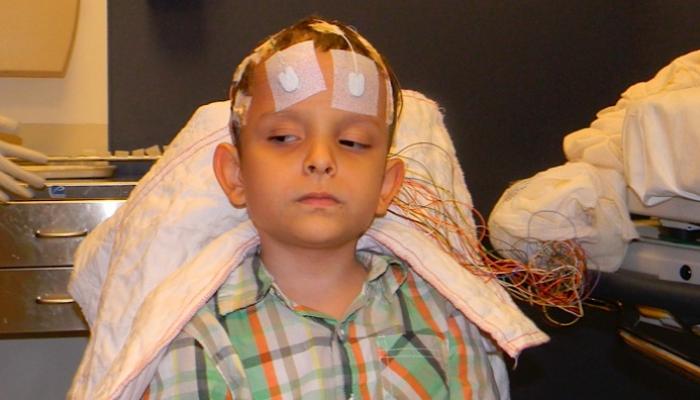
EEG stands for electroencephalography and it is a neurological test that records the electrical activity in the brain. EEGs are usually used to test for seizures or other abnormal brain activity.
If your child’s neurologist has ordered an EEG you may be wondering what the test will be like and whether or not it will be painful or traumatic for your child. You probably also want to know what sort of information the EEG will be able to tell you.
We’ll try to answer some of your questions about EEGs here.
Why Should My Child Have an EEG?
EEGs can give you invaluable information about your child’s brain. It is possible that your child is having seizures or abnormal brain waves that are disrupting their development, but you can’t even see them! Not all seizures are visible.
EEGs can also help provide information about sleep disorders or brain inflammation, but generally they are used to diagnose epilepsy and determine what types of seizures your child may be having so they can be better treated. The more information you have the better chance you’ll have to get those seizures under control.
How Do We Prepare for an EEG?
Usually there isn’t much that you have to do before an EEG. Generally you’ll be told to eat the same diet, take the same medications and sleep the same hours before your test, but sometimes your doctor may give you some special instructions.
Sometimes doctors want to see how your child’s brain reacts when they are tired or sleeping so they may ask that your child be “sleep deprived” for the test. They may want your child to fall asleep during the test so they can record sleeping brain waves. Doctors will also often ask that patients not drink caffeine before an EEG, but that’s not usually an issue for children!
You do not have to cut your child’s hair before an EEG, but it is a good idea to wash it and not use any conditioners or products in their hair so the glue sticks better.
How Long Will the EEG Take?
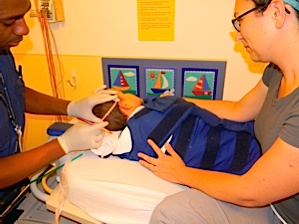 Most EEGs are done in the hospital for an hour or two, but your doctor may order a 24 hour, 48 hour (or longer) EEG. Long EEGs have the benefit of being more accurate because more data is being recorded, but of course they are also more invasive.
Most EEGs are done in the hospital for an hour or two, but your doctor may order a 24 hour, 48 hour (or longer) EEG. Long EEGs have the benefit of being more accurate because more data is being recorded, but of course they are also more invasive.
For long EEGs, you may be asked to stay in the hospital so your child can be monitored and video taped. That way if something abnormal shows up on their test there is video to correspond with it. But most often you will be sent home with an “ambulatory” EEG. In that case the EEG will be attached to your child’s head and covered with a hat or sock that attaches to a box that is recording the brain waves. You’ll be able to go about your routine in as normal a way as possible (while making sure to carry this little box every where you go) and your child will be able to sleep in their own bed. They won’t be able to take any baths, though! And make sure they are wearing a button-down shirt so you can change clothes if necessary (you won’t be able to pull anything over their head while they’re having the EEG).
For shorter EEGs, you can expect it to take anywhere from 45 minutes to an hour to get the EEG set up, another hour for the test, and usually a quicker 15 or 30 minutes to take everything off.
What is the EEG Like?
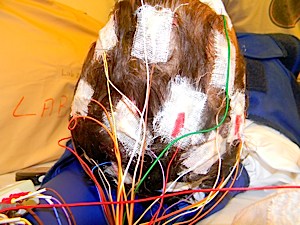 Any doctor or technician will tell you that EEGs are painless, and this is true. All they are doing is taking little metal disks called “leads” and gluing them to your child’s head. Easy and painless, right?
Any doctor or technician will tell you that EEGs are painless, and this is true. All they are doing is taking little metal disks called “leads” and gluing them to your child’s head. Easy and painless, right?
Well, you tell me. How is your child at sitting still for an hour while little metal disks are glued to their head? If that is something they can handle, then the test will be a breeze. For the rest of us, it can be quite difficult.
The hardest part is going to be getting those leads on your child’s head. Each technician has their own process, but usually we’ve seen the technician begin by drawing red marks on the head and measuring where all the leads will go. Then they will clean each spot with a gritty cream so that it’s ready for the lead. The lead is attached with a bit of goo and then covered with a small gauze patch and some glue. The glue may have to be hit with some air (from a tube) to get it to dry and set faster. And the glue smells awful! We’ve also had technicians skip the glue altogether and just use tape. It’s faster, but the leads are more likely to move around or fall off during the testing.
You’ll be asked to help hold your child down while the leads are being attached. This can be a two-person job! If you can’t get your child settled the technician may offer to use a “papoose.” This looks and sounds much worse than it really is. It’s a board with large fabric flaps that wrap around your child and velcro in place. Your child will be wrapped tight and unable to move (well, not much anyway). Ivan actually seemed to find the papoose comforting, although it may have been too warm.
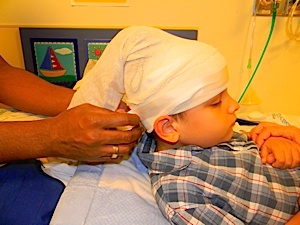 Once the leads are in place, the technician will wrap your child’s head so that everything stays put. Then the test begins. Even if you are going home for an ambulatory EEG, the technician will still record at the hospital first to get a baseline and make sure all the leads are working. They may play sounds for your child to listen to through headphones or they may flash strobe lights in a dark room. As mentioned above, they may try to get your child to sleep.
Once the leads are in place, the technician will wrap your child’s head so that everything stays put. Then the test begins. Even if you are going home for an ambulatory EEG, the technician will still record at the hospital first to get a baseline and make sure all the leads are working. They may play sounds for your child to listen to through headphones or they may flash strobe lights in a dark room. As mentioned above, they may try to get your child to sleep.
If you are leaving the hospital with the EEG then you will be sent home with a small box that all the leads are plugged into and that must be with your child at all times. The box will have a little red button on the side and if you see your child have a seizure or do anything you consider strange, you will be asked to press that button and record the time and describe the event in a little log. You should do your best to stick to your normal routine so you get accurate recordings, but it is hard to move around normally with wires on your kid’s head! We usually find ourselves just laying around and waiting for it all to be over.
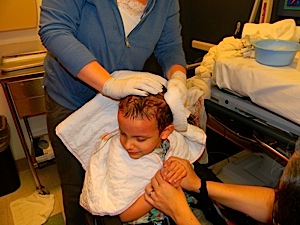 Taking the leads off is actually pretty easy. The technician will use a solvent that dissolves the glue and then they will do a quick wash of your child’s hair. You’ll do a better job of it when you get home! And if they used glue instead of tape, you will be picking glue out of your child’s hair for at least a week.
Taking the leads off is actually pretty easy. The technician will use a solvent that dissolves the glue and then they will do a quick wash of your child’s hair. You’ll do a better job of it when you get home! And if they used glue instead of tape, you will be picking glue out of your child’s hair for at least a week.
Test Results
The EEG will be read by doctors who specialize in EEGs and the results sent to your doctor. We usually have to go in to meet our doctor in his office to get our results. He will show us the seizures or spikes on the chart and explain what they mean, but honestly all the waves and spikes look ominous to me, even the normal ones. What’s really important is:
- Where is the abnormal activity? Is it localized in one part of the brain or is it global?
- How long does it last?
- Does it seem to happen at a particular time of day?
- Is there anything that precedes or follows the activity?
EEGs can answer these questions and this can help your doctor come up with ways to treat your child’s seizures. If you start a new medication, change a dose or begin another type of treatment (like the ketogenic diet), be sure to ask your doctor when your child should have the EEG repeated so you can see if the treatment is working. It’s probably a good idea to schedule that EEG now so you won’t have to wait for it later.
If you have any other questions about EEGs please send us an email or leave a comment below!
Read this article in Arabic: قراءة هذا المقال بالعربية
Read this article in Spanish: Lea este articulo en Español
Related Posts

Health & Nutrition
Can Baby Skin Care Products Expire?
Is that forgotten tube of diaper rash cream still safe to use? Learn more about the expiration dates of popular skin care products for infants.

Health & Nutrition
Boosting Immunity in Kids: 3 Tips for a Healthy Winter
Parents can help boost their kids’ immunity during cold and flu season by maintaining healthy eating, sleeping, and exercising habits in the winter.

Health & Nutrition
Flat Head Syndrome and Torticollis: What You Should Know
Torticollis, or tight muscles in the neck, may cause your baby to have a flat spot on their head that needs to be assessed and treated by a physician.